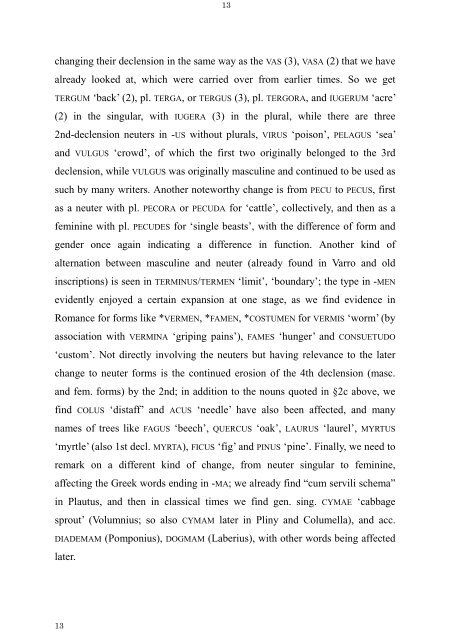The Latin Neuter Plurals in Romance - Page ON
The Latin Neuter Plurals in Romance - Page ON
The Latin Neuter Plurals in Romance - Page ON
You also want an ePaper? Increase the reach of your titles
YUMPU automatically turns print PDFs into web optimized ePapers that Google loves.
13<br />
13<br />
chang<strong>in</strong>g their declension <strong>in</strong> the same way as the VAS (3), VASA (2) that we have<br />
already looked at, which were carried over from earlier times. So we get<br />
TERGUM ‘back’ (2), pl. TERGA, or TERGUS (3), pl. TERGORA, and IUGERUM ‘acre’<br />
(2) <strong>in</strong> the s<strong>in</strong>gular, with IUGERA (3) <strong>in</strong> the plural, while there are three<br />
2nd-declension neuters <strong>in</strong> -US without plurals, VIRUS ‘poison’, PELAGUS ‘sea’<br />
and VULGUS ‘crowd’, of which the first two orig<strong>in</strong>ally belonged to the 3rd<br />
declension, while VULGUS was orig<strong>in</strong>ally mascul<strong>in</strong>e and cont<strong>in</strong>ued to be used as<br />
such by many writers. Another noteworthy change is from PECU to PECUS, first<br />
as a neuter with pl. PECORA or PECUDA for ‘cattle’, collectively, and then as a<br />
fem<strong>in</strong><strong>in</strong>e with pl. PECUDES for ‘s<strong>in</strong>gle beasts’, with the difference of form and<br />
gender once aga<strong>in</strong> <strong>in</strong>dicat<strong>in</strong>g a difference <strong>in</strong> function. Another k<strong>in</strong>d of<br />
alternation between mascul<strong>in</strong>e and neuter (already found <strong>in</strong> Varro and old<br />
<strong>in</strong>scriptions) is seen <strong>in</strong> TERMINUS/TERMEN ‘limit’, ‘boundary’; the type <strong>in</strong> -MEN<br />
evidently enjoyed a certa<strong>in</strong> expansion at one stage, as we f<strong>in</strong>d evidence <strong>in</strong><br />
<strong>Romance</strong> for forms like *VERMEN, *FAMEN, *COSTUMEN for VERMIS ‘worm’ (by<br />
association with VERMINA ‘grip<strong>in</strong>g pa<strong>in</strong>s’), FAMES ‘hunger’ and C<strong>ON</strong>SUETUDO<br />
‘custom’. Not directly <strong>in</strong>volv<strong>in</strong>g the neuters but hav<strong>in</strong>g relevance to the later<br />
change to neuter forms is the cont<strong>in</strong>ued erosion of the 4th declension (masc.<br />
and fem. forms) by the 2nd; <strong>in</strong> addition to the nouns quoted <strong>in</strong> §2c above, we<br />
f<strong>in</strong>d COLUS ‘distaff’ and ACUS ‘needle’ have also been affected, and many<br />
names of trees like FAGUS ‘beech’, QUERCUS ‘oak’, LAURUS ‘laurel’, MYRTUS<br />
‘myrtle’ (also 1st decl. MYRTA), FICUS ‘fig’ and PINUS ‘p<strong>in</strong>e’. F<strong>in</strong>ally, we need to<br />
remark on a different k<strong>in</strong>d of change, from neuter s<strong>in</strong>gular to fem<strong>in</strong><strong>in</strong>e,<br />
affect<strong>in</strong>g the Greek words end<strong>in</strong>g <strong>in</strong> -MA; we already f<strong>in</strong>d “cum servili schema”<br />
<strong>in</strong> Plautus, and then <strong>in</strong> classical times we f<strong>in</strong>d gen. s<strong>in</strong>g. CYMAE ‘cabbage<br />
sprout’ (Volumnius; so also CYMAM later <strong>in</strong> Pl<strong>in</strong>y and Columella), and acc.<br />
DIADEMAM (Pomponius), DOGMAM (Laberius), with other words be<strong>in</strong>g affected<br />
later.









